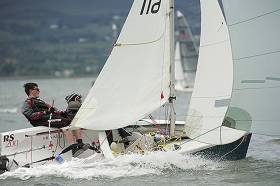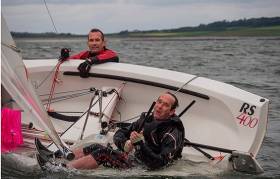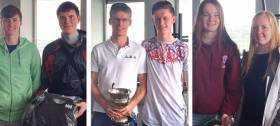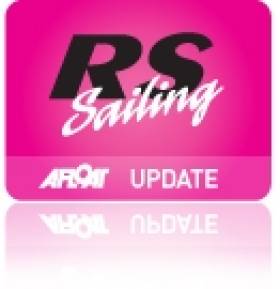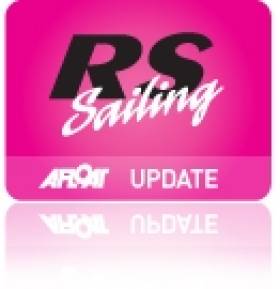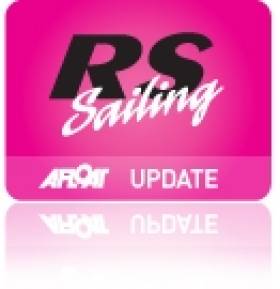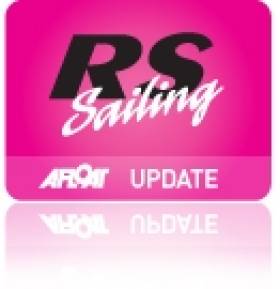Displaying items by tag: RS 200
Team GB's Saskia Tidey to Coach Irish RS200s
The Irish RS200 class association has announced Olympian Saskia Tidey has agreed to coach the Irish fleet for an ISA-supported class training weekend on Feb 4/5 at the Royal St George Yacht Club in Dun Laoghaire. Saskia competed for Ireland in the 49-er FX class in Rio and narrowly missed out on the Medal Race. Just recently, as reported on Afloat.ie HERE she has made the 'difficult' decision, with dual passports, to pursue a full time career with the GBR Olympic squad, with a target of qualifying for Tokyo 2020.
The Coaching weekend is open to all RS200 sailors and owners (of all standards) and will hopefully appeal to both seasoned campaigners from the established RS200 clubs up and down the country and perhaps also some newcomers from Cork where up to 8 new RS200s have arrived over the winter, with the Irish RS200 class association left searching for any available second hand boats in Ireland and the UK. The Cork Harbour interest has been helped in no small measure by encouragement from ISA All-Ireland Champion Alex Barry, see Afloat.ie report HERE. Indeed it seems apt that the RS200 Irish National Championships will take place at RCYC as part of Dinghyfest, June 30-July 2.
Further details on the Irish RS200 scene on www.RSIreland.com and the celebrated RS Crews Union Facebook page, where you can also keep up to date with the vibrant RS400 scene. Irish RS regional events incorporate all 3 RS fleets; Feva, 200 and 400, although larger fleets in all 3 for the respective National Championships will generally be held separately.
Saskia will focus on downwind boat-handling and technique. Here’s hoping for good weather this early in the season. We expect the shelter of the Harbour could yet prove invaluable.
See attached poster for event details and contact to register interest.
The next event on the circuit for the RS fleet is the Waterways Ireland Inland championships, being hosted by Lough Ree Yacht Club, on 23rd and 24th of July, All three fleets will be taking part in what was one of the highlights of the 2014 season, with lots of new comers to the fleet in both the 200s and 400s at their respective Westerns and Southerns event end of June, there should be tight racing across the board. This event will be a great one, with ample camping facilities on site.
This will be the last regional event before the fleets head for Schull for the National championships end of August.
The next RS Feva event is the Westerns in Galway next weekend – July 9th/10th as part of GBSCs DinghyWest.
The highlight of the year for the Fevas will be Feva Nationals, hosted by Greystones Sailing Club, making use of their fantastic new clubhouse and facilities. There are 10 races planned over the 3 days, and lots of social activities too. For the first time, the RS Feva class are taking a new approach to their Nationals, it will be held during the week from Mon 18th til Wed 20th of July.
All those who take part will be entered into a draw for a brand new Feva race jib, kindly donated by sponsors, McCready Sailboats. There will also be a separate prize for the first non XL (racing) sail – so even if you are sailing a club boat with training sails there will be good racing for you too. We are also hoping to get some parent and child teams competing – we have two potentially signed up already, and if we get 3 parent/child teams we will have a prize for that category. So….beg/steal/borrow a Feva/child and come and join in!!!
The Feva class will also be joining the 4s and 2s in Lough Ree for the Inlands on July 23rd/24th.
RS200 Dinghies Race at Greystones Sailing Club
12 RS 200 dinghies gathered at the newly opened Greystones Sailing Club for the Southern Championships last weekend, with boats from Dun Laoghaire, Antrim, Killaloe and Cullaun travelling for the event. There was also a great junior turnout, which made for some great racing through out the fleet.
Day one the fleet was met with 12–18 knots from the north west, and a fierce North going tide. In the challenging and unpredictable conditions, it was local legends Frank and son Kevin O'Rourke who took the overnight lead by a point over Marty O'Leary and Rachel Williamson.

Rs 200 Southern Champions Frank and Kevin O'Rourke
Day two brought lighter breeze with the fleet launching in pretty much 2 knots. Fortunately the breeze filled in from the south as forecast, and the race committee sucessfully manged to get 3 races away, to complete the 6 race series. The newest addition to the RS 200 fleet, also in the newest 200 in Ireland #1566, Jocelyn Hill and Katie Kane from CAYC were the pace setters for the day, but experience prevailed with Frank and Kevin holding on to win on countback from O'Leary and Williamson, (who suffered a small bung related incident), with Joecelyn and Katie taking Bronze.
Some other notable individual race results were Richard Frank and Rose Paget from RstGYC competing in their first RS regional, managing to secure a 2nd in race 5.
The junior division was won by Cullaun SC sailors Mike O'Dea and Sean Hynes, who sailed a great regatta, and coming out tops of the 6 junior boats.
A big thanks to the Race Management Team, lead by PRO Monica, and her able assistant Miriam, who had the unenviable task of running both the RS Southerns, and the club racing on both days. Thanks also to the safety boat crews, who's services Marty and Rachel were very grateful for on Sunday morning!
The next event is the Inland Waterways Ireland Western Championships on the 23rd and 24th of July in Lough Ree Yacht Club.
14–Boat 'Boisterous' RS Fleet Sailing in DMYC Frostbite Series
RSsailing – RS Sailors were on the water in Dun Laoghaire for yesterday afternoon's latest round of the DMYC dinghy Frostbite series writes Sarah Byrne.
With a lovely westerly breeze forecast on a crisp cloudless afternoon in the busy harbour, PRO Olivier opted for two races 'inside' on the default trapezoid. 14 boats on the RS start line proved boisterous and noisy at the Committee boat end, one OCS By Alexander Rumball in 1143 and a lone 200 owning the pin end.
The first beat proved uneventful with a cluster at the first mark and prompt hoists separating the wheat from the chaff down the first reach. At the second mark, some gybed away from the breeze bouncing around the HSS pier, only to arrive together again but with water at the next mark, then heading up onto a rather tight reach with some being forced to drop their kites. Multi fleet traffic forcing tacks spread the fleet further on the second beat. Marty & Rachel managed to maintain their lead throughout the four laps in the 200 fleet; Totts/Kelly battled with Enzo/Tom while Sarah/Katie hot in pursuit performed a particularly idiotic capsize to put them out of the race. Marty and Rachel came in just 1 second (on PY) behind the lead 400, Ross McDonald and Peter Bayly, taking joint second with Emmet and James Ryan.
Counting down to race two, with those in shorties beginning to get a bit chilly, the fleet were less unruly on the start line and again a lone boat owned the pin end. Two thirds up the first beat, the wind dropped and shifted a little to the north and hey ho a fishing boat comes barging through the fleet towards the first mark, messing it up a tad. Again Marty had made it first 200 to the top mark hunting down the new 400 pairing Sean Clery and Ronan Jones throughout and finishing together. Totts and Myles stayed just out of Sarah and Katie's reach for two of the three lap race when it was sadly and prematurely shortened as the Grannuaile demanded her passage through the course. On PY Marty and Rachel yet again owned the race, the Ryan Bros. and Andrew Algeo and Paul Nolan came in second and third overall.
Maeve Rafferty loving her new hull – thank you RS sailing! Quite the pleasant afternoon! The weekly Mug went to Ross McDonald and Peter Bayly for the first race and Emmet and James Ryan for the second race.
#RSsailing – Normally you have to drive for a couple of days with an overnight ferry and a long slow tunnel through a montagne to get sailing conditions like those enjoyed by the RS fleets at Strangford Lough, this weekend.
Sunshine both days normally means one good day, balanced by another with fickle breeze and a lot of sitting around. Thankfully the high pressure system in the Atlantic sat far enough the left to drag a steady northerly airstream whizzing straight down the lake like the Ora we so love in Italy. Okay, so it wasn't 25 degrees and in fresh water, no spectacular cliffs plunging into the lake as James Bond writes off a new Aston in the tunnel by the start line, and the sun was on the wrong side of the rig, but the breeze was super steady, with the only shift over 10 degrees was the one on Saturday night which meant the windward mark was set 100 metres left of its starting position the first day. It was also every bit as beautiful with the green rolling basket of eggs topography and low lying islands dotted around.
As always the crew at SLYC looked after us terrifically well, with a great team led by Mark Fletcher. Rock and roll on Saturday night was provided by the maestro himself, Charles Horder, outstanding.
With no hills to mess with the wind, we were treated to a fantastic force 2-4, with no need to muck about with the course between races. Speed is king in this sort of breeze = pain in the legs, but with the adrenaline maxing out on the dials, there was no time to complain. Needless to say, the kings of speed were Dr Bob and Mike Gunning, racking up 5 bullets to easily take the crown for the nth year in a row. With the result not really in doubt after Saturday's four races, many would be expected to plan an early drive home after Sundays two planned races, but that is not why we sail RS400s. A quick straw poll on Saturday after racing drew an unopposed majority decision to run an extra 7th race on Sunday. Just as well for many on Sunday race 1, as a bit of confusion spread from the pointy end to the middle of the running order, with half the fleet deciding to sail to the finish line after lap 2. Never a good thing to do in a three lapper, the race leaders were to limp home in double figures, and Espey rolled in the winner yet again.
Race 6 was notable for the fact that Bob and Mike didn't win, after Dr DC and Hardman Steve Kane romped off for one of the most impressive victories in living memory. Their amazing uphill speed, mostly fear driven, was to immediately desert them in race 7, with the usual running order resuming and a 5th Espey bullet. If it sounds like the event winners had an easy ride, it wasn't the case, with plenty of teams pushing them hard before their class brought them through in the end. Multiple Irish Champions Gareth Flannigan and Dave Fletcher bagged lots of 2s to claim a deserved 2nd, and Sean Cleary and Steve Tyner would undoubtedly have got a bit closer with some more consistency, as they were frequently the only ones with boat speed to match the Ballyholme duo.
First geriatrics were Dr C and Stevie Kane in 4th, courtesy of 2 wins and Dave Rose's exploding rudder stock, which stymied his impressive upward progress since joining the fleet this year. Another new face getting faster all weekend was Chris Penney, ex laser Champion, slotting in at 7th in their first event, whilst Aidan MacSweeney of Corkway scored his first top 10 in 9th, despite having the handicap of Ben Duncan crewing for him. Robbie Gilmore with his old man John, showed that Charlie Horder's horse is actually a very fast boat in the right hands, as top SLYC team in 10th, and first laydee was Paul McMahon in 12th. We were also treated to the sight of the great Peter Kennedy finally racing a 400, thanks to Saturday-racing-only-please Terry Fair's generous loan of his boat.
So, 25 RS400s at a regional event......getting hotter!
Given the timing of this event the RS200 and Feva fleets were much depleted by exams and holidays. The Fevas were won by this years new pairing of Alison Dolan and Grainne Young from Blessington and NYC respectively, followed in second by Triona Hinkson with Cathy Kelly from the RSGYC. Third overall was Helen O Beirne and Cliona Coyle. Also out in their first event were local girls Juliette Kennedy and Lucy Bell. Testing conditions in the wind for these youngsters who all showed remarkable boat handling. The 200s were won by Sarah Byrne and Heather King from Greystones and RSGYC, followed by Aaron Jones and Conor Clery also from Greystones. Third was father and daughter paining of Michael and Meg Tyrell from RIYC.
Next event up for the RS family is the Westerns at Lough Ree on July 19/20th.
Results here
#rssailing – There was a buzz in the Monkstown Bay SC dinghy park last Saturday morning writes David Rose. There was a real feeling of a fresh start for dinghy sailing in this part of the world, with 20 boats hitting the start line and many new teams competing for the first or second time in the Feva, RS200 and RS400 classes alongside seasoned campaigners. Overall results are available to download below.
There were some nerves and a lot of smiling faces as the teams got through the formalities of rigging and entering, which included a barbecue later that day to replenish the energy spent on the water.
It was clear from the forecast and the talk in the dinghy park that it was going to be a day full of exertion, with an 8 race program to be run over one day. This format is designed to be just as competitive as regional events, but with an emphasis on getting as much sailing in as possible allowing crews to improve their performance. General recalls and protests don't come into it, it's all about the sailing, which makes for a very enjoyable and productive outing for all.
Monkstown was out in strength with a small army of volunteers ensuring that everything was running smoothly and it was.
Racing got underway in glorious conditions, with gusts coming down a sunny racecourse packed with boats. The spectacle was fantastic, and a local sailor viewing from a spectator boat commented to me afterwards that we could have charged for tickets, the racing was so good to watch, with boats flying into the leeward gate from every angle at high speeds.
The race team provided rapid fire 3,2,1 go races with minimal delays, and 8 races were sailed over a long but exhilarating day. Many teams were feeling exhausted when they hit the dock, with some people asking their fellow competitors for help pulling their boats out of the water after giving their all to the racing.
The energy and enthusiasm for the sport was palpable ashore, with crews beaming from ear to ear and telling each other just how wrecked they felt. There was a superb atmosphere in the bar afterwards and it seemed fitting that Alex Barry who had organised the event took the honours in the RS400 class with Paul O'Sullivan crewing, followed by another impressive local performance from John Downey and Sandy Rimmington.
The 200's were won by Trevor Fisher and Heather King who showed great support for the class by making the trip to Cork so soon after a sprint in NI.
The Feva's were won by Cork sailors Harry Durcan and Peter Hyland of the RCYC.
Onwards and upwards for this group of classes. I feel we could get another few new joiners from the success of this non ranking sprint event alone. Many people waxed lyrical about how enjoyable and challenging these two handed boats are to sail.
The next outing is the Northerns, followed by the Westerns and then Riva Del Garda in Italy and a Nationals in Galway before returning to the South for a Kinsale southerns. This is an action packed circuit.
Thanks to OOD Ciarán McSweeney, sponsors the Bosun Bar & Guesthouse and Ramen - "Asian Street Food" and most importantly the army of volunteers from Monkstown Bay who put on an amazing event and fed all of the sailors with a BBQ after etc.
RS Sailors at Blessington for Inland Champs
#RSsailing – Blessington Sailing Club is hosting the 2013 RS Inland championships and after three races Franks and Kevin O'Rourke lead the biggest fleet, the 12–boat RS200s. Blessington's own Alison Dolan and Grainne Young top a 6–boat Feva fleet. Another Greystones boat, sailed by Simon Herriott and Tom Moran, lead the 11–boat RS400 fleet. Results to date are downloadable below as a html file.


























